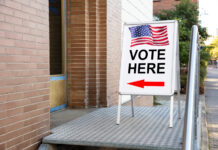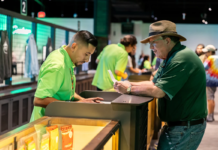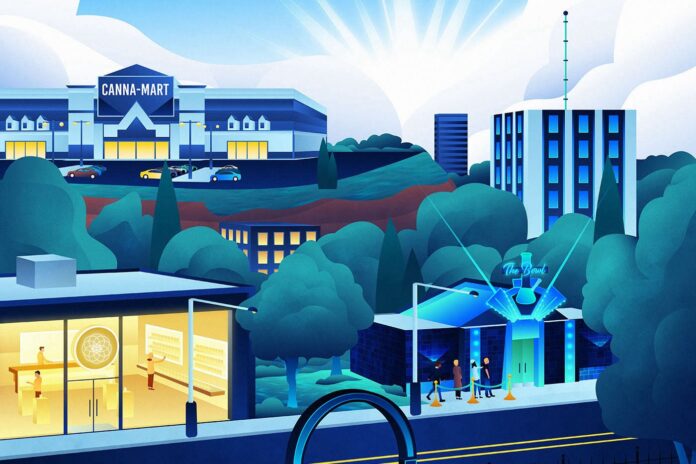Fully legal cannabis has gone from being an unattainable dream to a reality within reach. As the industry mentally prepares for the end of prohibition, operators everywhere are imagining what’s in store for cannabis retail.
Dispensaries have come a long way over the past decade, evolving from blacked-out, trap-like holes in the wall to transparent, high-tech operations displaying the best of the industry for every type of consumer. All this has taken place while the plant remains federally illegal.
Clearly, a lot of room for improvement and innovation remains, causing experts and observers to wonder whether dispensaries of the future will resemble Walmart, Bloomingdale’s, or something else entirely.
Globally shifting sentiments exert an influence
Any consumer or entrepreneur who has dealt with the industry for the past decade or longer is well aware how dramatically dispensary setups have changed. As the plant slowly but surely became legal in most states, medical and adult-use operations seized the opportunity to step out of the shadows and be a little louder about their existence.
As a result, dispensaries went from discreet to enticing. And since cannabis retail evolved so much in just the past ten years, experts can’t help speculating what the next evolution might encompass.
“We’re beginning to see a seismic shift around cannabis sentiments globally,” said Thomas Winstanley, vice president of marketing at Theory Wellness. “Pew Research recently put out a study saying 98 percent of Americans support legal cannabis now.
“That has a major impact on our operations,” he continued. “We’re trying to fine-tune a balance of making sure we’re still catering to our medical patients while knowing there’s a new audience coming through the door every day.”
The shift is nowhere near finished. The industry continues to evolve at a rapid pace, and executives like Winstanley aim to remain aligned with consumers in order to stay relevant, competitive, and engaging. In order to do so, they must recognize how widely the market varies from state to state and region to region. Legislatures have legalized recreational use in only about half of states where medical use is legal. Although recreational legalization undoubtedly will spread, the current disparity exerts a powerful influence on companies that operate in multiple markets.
Take the East Coast, for example. Although New York, New Jersey, and Virginia have some experience with medical programs, they’re still sorting out recent recreational legalization. That complicates how multistate operators (MSOs) like Jushi Holdings adjust their business models.
“As the industry continues to legalize, we have to make sure each of our markets continues to respect our medical patients,” said Chief Creative Officer Andreas Neumann, who oversees retail development in East Coast markets. “We’ve seen other markets go recreational and forget about their medical patients, but it’s very important to keep their needs in mind” when planning both product mix and new locations.
He believes technology can play a large role in helping retailers serve medical patients in ways that will keep them engaged. “We have a futurist at our company who predicts artificial intelligence is the next thing coming for medical dispensaries, collecting data to help treat medical conditions earlier on where possible,” he said. “I think the industry as a whole is still really in the beginning phase of product sophistication.”
According to Neumann, dispensaries that focus on adult-use sales tend to perform better in bustling downtown areas where people are likely to wander in off the street and browse, but medical patients are more likely to know what they want before they walk in the door. They also prefer a streamlined, simplified purchasing experience.
“In Las Vegas, you have cannabis dispensaries on the Strip. From blasting music to bright designs, that experience is going to be similar to that of a hip sneaker store. The idea there is cannabis tourism, or people wandering in to browse after a night out,” he said. “But with medical patients, those consumers are more likely to stick to a dispensary within six miles of where they live, and they’re looking for a cleaner, simpler, pharmacy-like vibe.
“When planning for these differing locations, you really have to hit its nerve and have various concepts ready for layout,” he added.
Integration into the healthy lifestyle movement
On the West Coast, where cannabis has been legal for more than two decades, companies have discovered medical and recreational consumers share common needs and desires.
“When you’re talking about agricultural practices for healthy consumption, it doesn’t make a huge difference whether it’s for the medical or adult-use market,” said Jeff Finnerty, vice president of marketing at Ayr Wellness. “Even in the strictly adult-use market, we have wellness-focused products that address specific symptoms or conditions. We want to be able to have something to meet every cannabis consumer where they are on their journey: new, seasoned, looking to spend more or less, looking to address a very specific ailment, or just looking to socialize with friends and some good flower.”
In fact, more developed pockets of the industry seem to be embracing the same transition from clearly defined segments—medical and recreational—to a sort of wellness umbrella encompassing both use cases.
To take things a step further, experts don’t expect the plant to develop as an isolated wellness sector. Instead, many believe cannabis is well on its way to becoming an integral part of the broader health-and-wellness consumer packaged goods industry.
“There are simply endless opportunities for integrating CBD and THC into wellness and lifestyle,” said Nicklas Brandrup, cofounder of CBD brand Neurogan. “We’ve explored this opportunity in a lot of ways with existing private-label clients, and the main concern is always whether or not the addition of cannabis into their brand is simply too risky. Removing the risk layer [with legalization and destigmatization] will remove the anxiety business owners have when considering the introduction of cannabis into their portfolio. And with that, I expect the weed stigma to disappear at an exponential rate.”
Regional differences will continue
With all the distinctions among different markets, it’s difficult to imagine a day when operators will be able to take a market-agnostic approach to either regions or consumer types. But in terms of whether the future of dispensaries will be Walmart or Bloomingdale’s, most experts believe there will be room—and demand—for both. Some consumers will gravitate toward boutique, jewelry-store-type experiences that emphasize product quality and consumer experience, while others will prioritize getting the most bang for their buck in the most streamlined way possible. The former group likely will prize personalized service, while the latter will embrace delivery or pickup options that require minimal human interaction.
“I think we’ll eventually see three different models: people going for cheap and simple; stores that monetize the convenience of having a downtown-centric, highly populated location; and stores that create a unique enough experience for consumers to really go out of their way to visit,” said Nick Kovacevich, chief executive officer at distributor Greenlane.
“If you go to a lower-income area, the consumer isn’t going after experience; they’re going after convenience and price point,” he added. “But if you go to a wealthier area, people are looking for a different experience—limited releases, rewards programs … that boutique feel. And if you’re in a main zone with heavy foot traffic, you just need a large [product] selection and decent prices.”
Depending on location, some dispensaries will always opt to keep things simple and affordable, while others have room to get a little more creative with their approach to connecting with surrounding communities. A prime example of this is taking place in West Hollywood (WeHo), California, where operators are leading the charge in cannabis tourism, lounges, and experiential retail.
“WeHo is paving the way for normalizing cannabis culture,” said Scott Schmidt, executive director at Emerald Village West Hollywood, the first municipal travel and tourism association devoted to cannabis businesses. “Dispensaries in some newer states still have metal bars in the windows, leaving it entirely up to people’s imagination what’s happening inside. And if you have a negative opinion of cannabis, it allows you to imagine whatever negatives you want.”
Schmidt said Emerald Village opts for locations that make consumers feel curious, welcome, and ready to fill their Instagram feed with the stores’ creativity and cleverness. “Our locations have floor-to-ceiling windows, and passersby see this fabulous store they want to come in and check out,” he said. “This approach is much more inviting to the canna-curious. They want to be able to have that conversation with a budtender in an approachable environment.”
National presence with hyper-local appeal
While the East Coast and Middle America continue to feel their way through dispensary design and operational approaches, older markets where stigmas aren’t so close to the surface anymore have the luxury of focusing on welcoming spaces, lifestyle fusion opportunities like cannayoga and tourism collaborations, and interiors that tell a story and connect consumers to both the plant and the community.
“We want each of our stores to have a little local flair and some form of contributing back to that community,” Ayr Wellness’s Finnerty said. “For example, if a dispensary is near the beach, that staff regularly contributes to beach cleanups. Other locations donate a portion of proceeds to a local food drive, while still others commission local artists to create murals or store installations. We try to unify our brand but also stay very connected to the communities at a local level.”
Theory Wellness’s Winstanley sees the industry integrating into the larger commercial culture as it matures. “I would love to see cannabis brands sponsoring athletic competitions someday like alcohol does, or social consumption lounges where people can enjoy a spliff in the same way they enjoy a beer,” he said. “Cannabis is going to be a major part of the overall social fabric.”
Cannabis’s retail future almost certainly doesn’t consist of a one-size-fits-all approach. Just as alcohol and tobacco experiences range from corner liquor stores to sophisticated wineries and cigar lounges, the cannabis experience will exist in a wide range of styles, each designed to serve a slice of the consumer population. Just like any other retail sector.










[…] speakers, the shop is less like a classic Santa Ana in-and-out dispensary and more akin to the luxury traditional retailers on swanky, nearby Bristol […]
[…] the retail side, the customer shopping experience is going deeper into digital as companies implement new technologies to see, smell, interact, and […]
[…] cannabis industry matures, regulatory restrictions are becoming less stringent, paving the way for dispensaries to operate more like traditional retailers and cannabis to become a normal part of everyday activities. This situation opens the door for […]
[…] of the key aspects of building a successful dispensary is creating a strong retail experience for consumers. This includes optimizing the store’s product catalog and managing the inventory […]